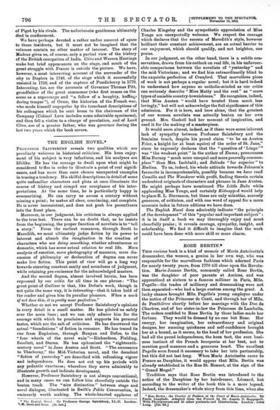ROSE BERTIN.* THIS curious book is a kind of memoir
of Marie Antoinette's dressmaker, the woman, a genius in her own way, who was responsible for the marvellous fashions which adorned Paris for nearly twenty years, from 1770 till close upon the Revolu- tion. Marie-Jeanne Bertin, commonly called Rose Bertin, was the daughter of poor parents at Amiens, and was apprenticed at sixteen to a famous milliner in Paris, Mile. Pagelle—the trades of millinery and dressmaking were not then separated—who had a large custom among the great. A lucky chance brought Mlle. Pagelle's young employee under the notice of the Princesse de Conti, and through her of Mlle. de Penthievre shortly before her marriage with the Due de Chartres, and of her sister-in-law the Princesse de Lamballe. The orders confided to Rose Bertin by these ladies made her fortune. They would be dressed by no one but Rose. Her energy, her imagination, her extraordinary and original designs, her amazing quickness and self-confidence brought her at a bound, as it seems, to the head of her profession. She had all the proud independence, the keen tact, the sure busi- ness instinct of the French bourgeoise at her best, not to mention good manners and a generous heart. The excellent Pagelle soon found it necessary to take her into partnership, but this did not last long. When Marie Antoinette came to France as Dauphine, it would appear that Mlle. Bertin was already established in the Rue St. Honore, at the sign of the " Grand Mogol."
Tradition says that Rose Bertin was introduced to the notice of the Dauphine by her hairdresser, Leonard, but according to the writer of the book this is a mere legend. Indeed, the dressmaker's whole story from this time, when she
• Rose Bertin : the Creator of Fashion at the Court of Marie Antoinette. By Emile Langlade. Adapted from the French by Dr. Angelo S. Rappoport. With Photogravure and 33 other portraits and illustrations. London John Long. [12s. 6d.] became, we may say, the arbiter and director of fashion in France, seems to be hopelessly entangled in sham Memoirs and Souvenirs, and mixed up with all the Court gossip, mostly false, which hangs about the name of Marie Antoinette. Their intercourse may have been too easy for strict etiquette, but not a natural act of kindness done by the Queen to her dress- maker, whose name, as the years went on, became familiar to all the Courts of Europe-such as the honour of a seat in the royal theatre at Manly-but was laid hold of, twisted, blackened by the society that went about dressed in Mlle. Bertin's paniers and poufs, or decked with some of the other wondrous headgear shown in the illustrations to this book.
The curious descriptions of fashion and the accounts of Mlle. Bertin's trade will attract some readers. Others may prefer dwelling on a friendship and loyalty-deserved on both sides-which were near their tragic severance in 1792, when Rose Bertin waited on the Queen at the Tuileries and Marie Antoinette said to ben: "I dreamed of you last night, my dear Rose. I thought you brought me a lot of coloured ribbons, and that I chose several, but they all turned black as soon as I took them in my hands."
The Court dressmaker survived the Revolution in which most of her royal and noble patrons disappeared. She left Paris for a time, but never actually emigrated, returning to a trade which, though it did not recover its former splendour and was weighed down with debts, yet kept her and a few old Royalist friends from poverty. She died in 1813, not an old woman, at her country house at Epinay. Her character, her genius, and her extraordinary practical talent seem to deserve a better memorial than this book, full as it is of scattered and curious detail. Rose Bertin, in her own way, was one of the leading minds of the reign of Louis XVI.
The illustrations are interesting and amusing. But we fancy an evidently seventeenth-century Princesse de Conti is out of place among them.































































 Previous page
Previous page